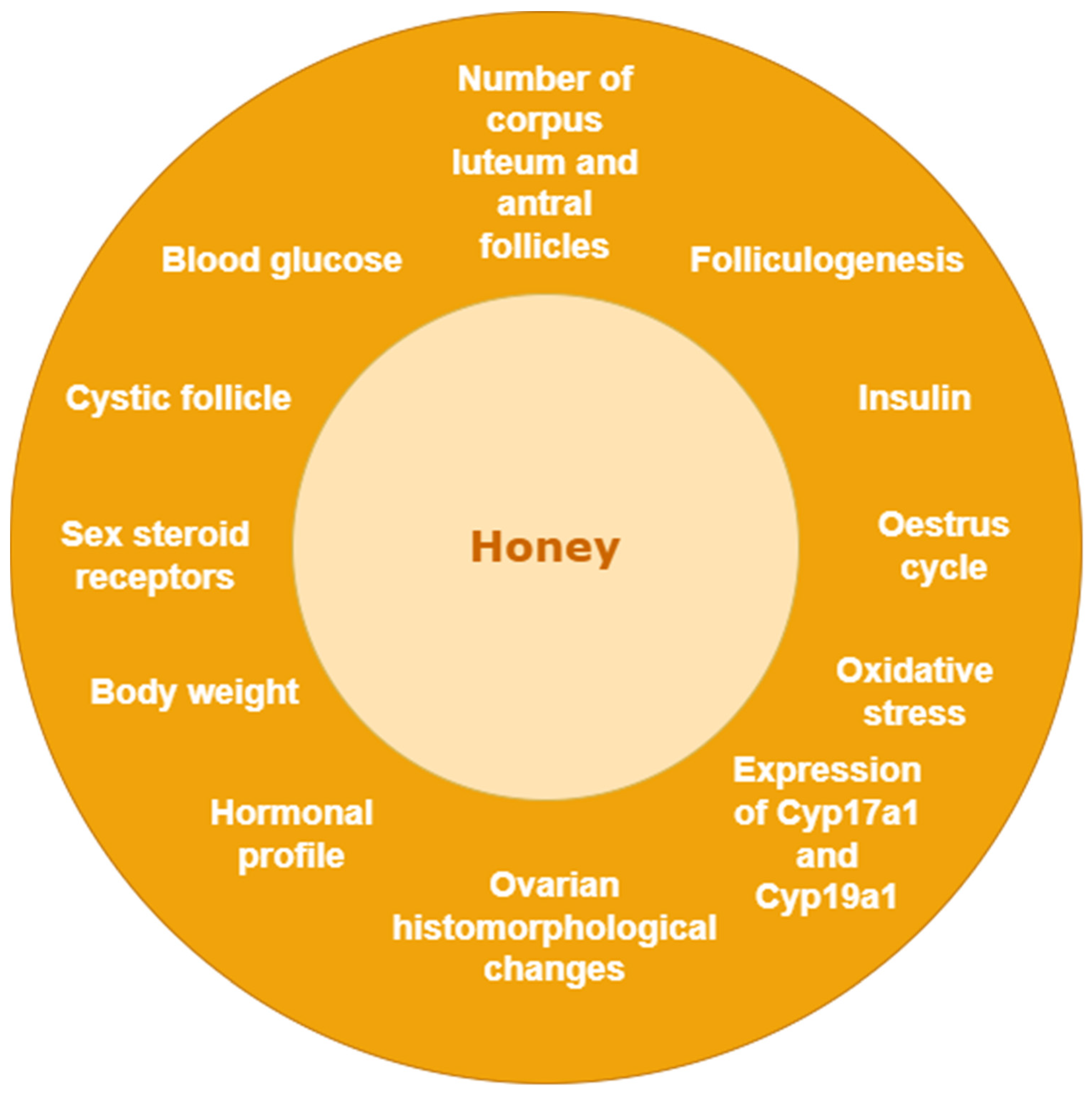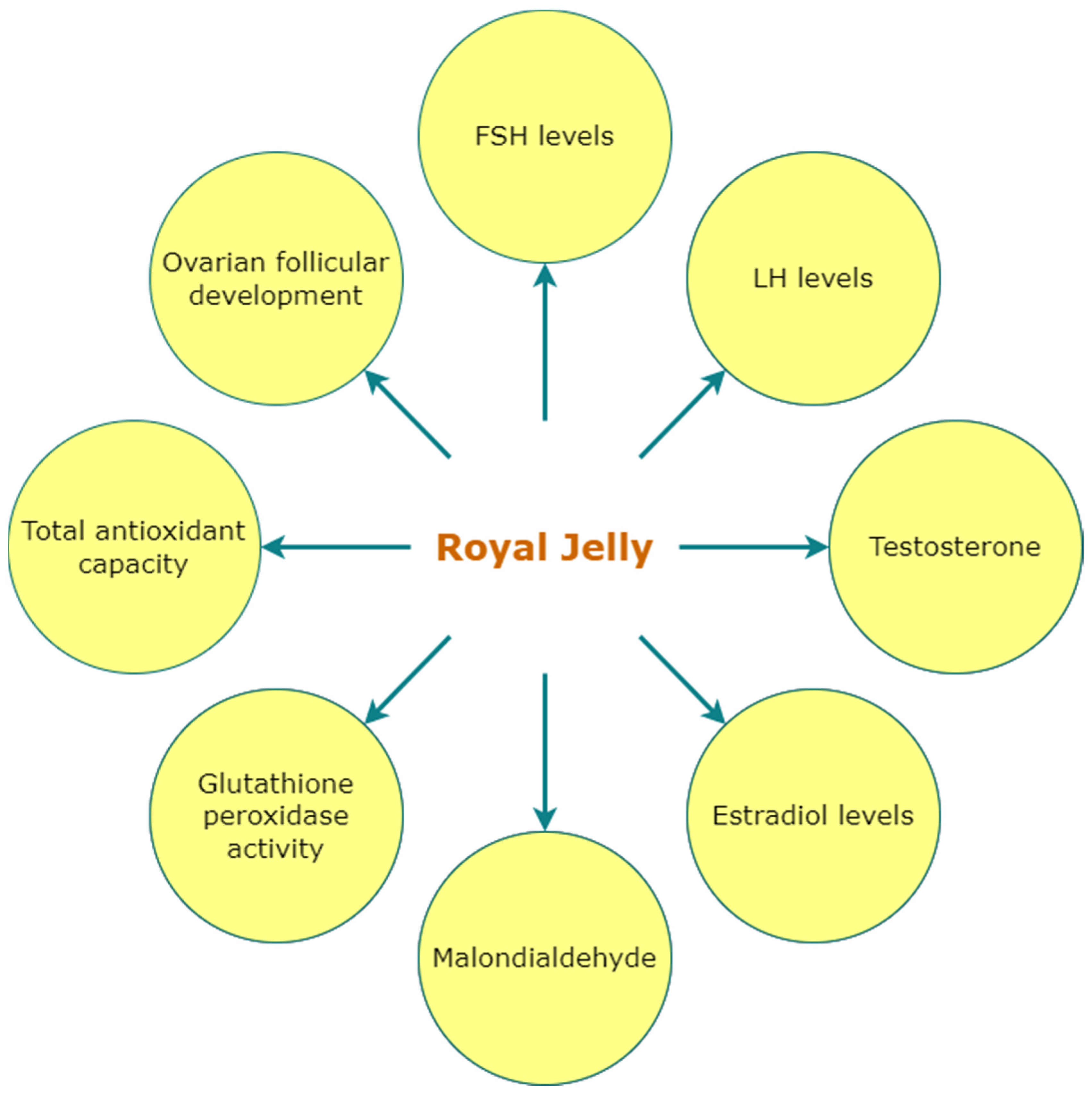
| Version | Summary | Created by | Modification | Content Size | Created at | Operation |
|---|---|---|---|---|---|---|
| 1 | Additiya Paramanya | -- | 2044 | 2023-04-11 19:09:26 | | | |
| 2 | Catherine Yang | Meta information modification | 2044 | 2023-04-12 04:16:59 | | |
Video Upload Options
Bee products, including honey, have been utilized since ancient times for nutritional and therapeutic purposes. Other bee products such as bee pollen, royal jelly, and propolis have caught a lot of attention. Being high in antioxidants and bioactive compounds, these products have established their applications in the pharmaceutical field as supplementary or alternative medicines. Polycystic ovarian syndrome (PCOS) as a hormonal disorder in which the ovaries produce an irregular quantity of androgen. Bee products, especially honey, have been used since ancient times as a safer alternative to sugar. Being rich in antioxidants, honey indirectly helps PCOS patients by lowering the risk of oxidative stress, inflammation, and type-2 diabetes.
1. Honey

2. Honeybee Venom

3. Royal Jelly

4. Bee Pollen

5. Propolis

References
- Kozłowicz, K.; Różyło, R.; Gładyszewska, B.; Matwijczuk, A.; Gładyszewski, G.; Chocyk, D.; Samborska, K.; Piekut, J.; Smolewska, M. Identification of sugars and phenolic compounds in honey powders with the use of GC–MS, FTIR spectroscopy, and X-ray diffraction. Sci. Rep. 2020, 10, 16269.
- Santos-Buelga, C.; González-Paramás, A.M. Chemical Composition of Honey. In Bee Products-Chemical and Biological Properties; Springer: Cham, Switzerland, 2017; pp. 43–82.
- Moniruzzaman, M.; Rodríguez, I.; Ramil, M.; Cela, R.; Sulaiman, S.; Gan, S. Assessment of gas chromatography time-of-flight accurate mass spectrometry for identification of volatile and semi-volatile compounds in honey. Talanta 2014, 129, 505–515.
- Suto, M.; Kawashima, H.; Nakamura, Y. Determination of Organic Acids in Honey by Liquid Chromatography with Tandem Mass Spectrometry. Food Anal. Methods 2020, 13, 2249–2257.
- Cadoret, V.; Jarrier-Gaillard, P.; Papillier, P.; Monniaux, D.; Guérif, F.; Dalbies-Tran, R. Leukemia inhibitory factor modulates the differentiation of granulosa cells during sheep in vitro preantral to antral follicle development and improves oocyte meiotic competence. Mol. Hum. Reprod. 2021, 27, gaab051.
- Kamal, D.A.M.; Ibrahim, S.F.; Ugusman, A.; Zaid, S.S.M.; Mokhtar, M.H. Kelulut Honey Improves Folliculogenesis, Steroidogenic, and Aromatase Enzyme Profiles and Ovarian Histomorphology in Letrozole-Induced Polycystic Ovary Syndrome Rats. Nutrients 2022, 14, 4364.
- Kamal, D.A.M.; Ibrahim, S.F.; Ugusman, A.; Mokhtar, M.H. Kelulut Honey Ameliorates Oestrus Cycle, Hormonal Profiles, and Oxidative Stress in Letrozole-Induced Polycystic Ovary Syndrome Rats. Antioxidants 2022, 11, 1879.
- Lee, Y.H.; Yang, H.; Lee, S.R.; Kwon, S.W.; Hong, E.-J.; Lee, H.W. Welsh Onion Root (Allium fistulosum) Restores Ovarian Functions from Letrozole Induced-Polycystic Ovary Syndrome. Nutrients 2018, 10, 1430.
- Kamal, D.A.M.; Ibrahim, S.F.; Ugusman, A.; Mokhtar, M.H. Effects of Kelulut Honey on Oestrus Cycle Regulation and Histomorphological Changes in Letrozole-Induced Polycystic Ovary Syndrome Rats: A Preliminary Study. Life 2022, 12, 890.
- Al-Rahbi, B.; Zakaria, R.; Othman, Z.; Hassan, A.; Ahmad, A.H. Enhancement of BDNF Concentration and Restoration of the Hypothalamic-Pituitary-Adrenal Axis Accompany Reduced Depressive-Like Behaviour in Stressed Ovariectomised Rats Treated with Either Tualang Honey or Estrogen. Sci. World J. 2014, 2014, 310821.
- Jakimiuk, A.J.; Weitsman, S.R.; Yen, H.-W.; Bogusiewicz, M.; Magoffin, D.A. Estrogen Receptor α and β Expression in Theca and Granulosa Cells from Women with Polycystic Ovary Syndrome. J. Clin. Endocrinol. Metab. 2002, 87, 5532–5538.
- Kamal, D.A.M.; Ibrahim, S.F.; Ugusman, A.; Mokhtar, M.H. Kelulut Honey Regulates Sex Steroid Receptors in a Polycystic Ovary Syndrome Rat Model. Int. J. Mol. Sci. 2022, 23, 14757.
- Ahmed, S.; Sulaiman, S.A.; Othman, N.H. Oral Administration of Tualang and Manuka Honeys Modulates Breast Cancer Progression in Sprague-Dawley Rats Model. Evid.-Based Complement. Altern. Med. 2017, 2017, 5904361.
- Wehbe, R.; Frangieh, J.; Rima, M.; El Obeid, D.; Sabatier, J.-M.; Fajloun, Z. Bee Venom: Overview of Main Compounds and Bioactivities for Therapeutic Interests. Molecules 2019, 24, 2997.
- Nabiuni, M.; Nasri, S.; Poyanmanesh, F.; Karimzadeh, L.; Nazari, Z. Honey Bee Venom Modulates Hyperglycemia in Response to Hyperandrogenism in Polycystic Ovarian Syndrome-Induced Wistar Rats, Chapters. In International Conference on Applied Life Sciences; Nejadkoorki, F., Ed.; IntechOpen: Rijeka, Croatia, 2012.
- Tokuyama, O.; Nakamura, Y.; Musoh, A.; Honda, K.-I.; Ozaki, K.; Ishiko, O. Expression and distribution of cyclooxygenase-2 in human ovary during follicular development. Osaka City Med. J. 2003, 49, 39–47.
- Pouyanmanesh, F.; Nabiuni, M.; Nasri, S.; Nazari, Z.; Karimzadeh, L. The effect of honey bee venom on levels of lipids and anti-mullerian hormone in a rat with polycystic ovarian syndrome. Feyz J. Kashan Univ. Med. Sci. 2013, 17, 239–246. Available online: http://feyz.kaums.ac.ir/article-1-1954-en.html (accessed on 23 October 2022).
- Ali, A. Laparoscopic intraovarian injection of bee venom in the treatment of polycystic ovarian disease: A new modality. Obstet. Gynecol. 2000, 95, S15.
- Yasin, M.M.; Abdelfatah, E.; Hamada, H.; Yousef, A.; Shahin, M.; Mosaad, D. Effect of bee venom phonophoresis in obese polycystic ovarian women: A Single Blind Randomized Controlled Trial. J. Appl. Pharm. Sci. 2018, 8, 159–164.
- Xue, X.; Wu, L.; Wang, K. Chemical Composition of Royal Jelly. In Bee Products—Chemical and Biological Properties; Alvarez-Suarez, J.M., Ed.; Springer International Publishing: Cham, Switzerland, 2017; pp. 181–190.
- Kocot, J.; Kiełczykowska, M.; Luchowska-Kocot, D.; Kurzepa, J.; Musik, I. Antioxidant Potential of Propolis, Bee Pollen, and Royal Jelly: Possible Medical Application. Oxid. Med. Cell. Longev. 2018, 2018, 7074209.
- Xin, X.-X.; Chen, Y.; Chen, D.; Xiao, F.; Parnell, L.D.; Zhao, J.; Liu, L.; Ordovas, J.M.; Lai, C.-Q.; Shen, L.-R. Supplementation with Major Royal-Jelly Proteins Increases Lifespan, Feeding, and Fecundity in Drosophila. J. Agric. Food Chem. 2016, 64, 5803–5812.
- Kunugi, H.; Ali, A.M. Royal Jelly and Its Components Promote Healthy Aging and Longevity: From Animal Models to Humans. Int. J. Mol. Sci. 2019, 20, 4662.
- Ghanbari, E.; Khazaei, M.R.; Khazaei, M.; Nejati, V. Royal Jelly Promotes Ovarian Follicles Growth and Increases Steroid Hormones in Immature Rats. Int. J. Fertil. Steril. 2018, 11, 263–269.
- Mărgăoan, R.; Stranț, M.; Varadi, A.; Topal, E.; Yücel, B.; Cornea-Cipcigan, M.; Campos, M.G.; Vodnar, D.C. Bee Collected Pollen and Bee Bread: Bioactive Constituents and Health Benefits. Antioxidants 2019, 8, 568.
- Kostić, A.; Milinčić, D.D.; Barać, M.B.; Shariati, M.A.; Tešić, Ž.L.; Pešić, M.B. The Application of Pollen as a Functional Food and Feed Ingredient—The Present and Perspectives. Biomolecules 2020, 10, 84.
- Kostić, A.; Milinčić, D.; Nedić, N.; Gašić, U.; Trifunović, B.; Vojt, D.; Tešić, Ž.L.; Pešić, M. Phytochemical Profile and Antioxidant Properties of Bee-Collected Artichoke (Cynara scolymus) Pollen. Antioxidants 2021, 10, 1091.
- Kostić, A.; Milinčić, D.D.; Gašić, U.M.; Nedić, N.; Stanojević, S.P.; Tešić, Ž.L.; Pešić, M.B. Polyphenolic profile and antioxidant properties of bee-collected pollen from sunflower (Helianthus annuus L.) plant. LWT 2019, 112, 108244.
- Komosinska-Vassev, K.; Olczyk, P.; Kaźmierczak, J.; Mencner, L.; Olczyk, K. Bee Pollen: Chemical Composition and Therapeutic Application. Evid.-Based Complement. Altern. Med. 2015, 2015, 297425.
- Park, Y.K.; de Alencar, S.M.; Aguiar, C.L. Botanical Origin and Chemical Composition of Brazilian Propolis. J. Agric. Food Chem. 2002, 50, 2502–2506.
- Pietta, P.; Gardana, C.; Pietta, A. Analytical methods for quality control of propolis. Fitoterapia 2002, 73, S7–S20.
- Walker, P.; Crane, E. Constituents of propolis. Apidologie 1987, 18, 327–334.
- Wagh, V.D. Propolis: A Wonder Bees Product and Its Pharmacological Potentials. Adv. Pharmacol. Sci. 2013, 2013, 308249.
- Sapmaz, T.; Sevgin, K.; Topkaraoglu, S.; Tekayev, M.; Gumuskaya, F.; Efendic, F.; Pence, M.E.; Aktas, S.; Hekimoglu, G.; Irkorucu, O. Propolis protects ovarian follicular reserve and maintains the ovary against polycystic ovary syndrome (PCOS) by attenuating degeneration of zona pellucida and fibrous tissue. Biochem. Biophys. Res. Commun. 2022, 636, 97–103.




